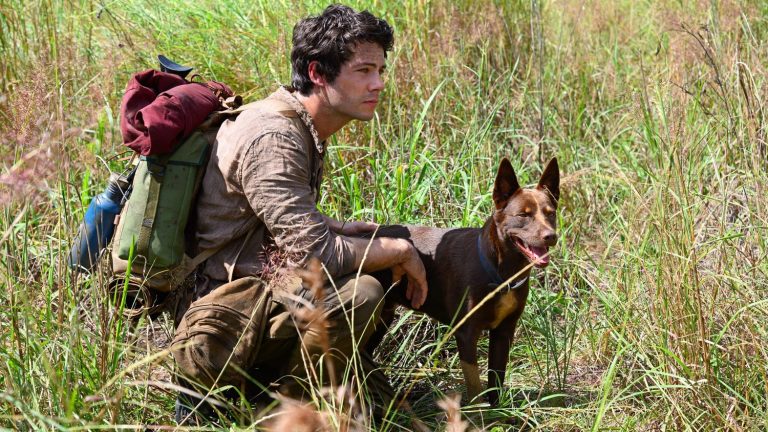Love and Monsters: How a Robot and a Dog Became the Heart of Netflix’s Apocalyptic Romp
Communication is key, Netflix’s Love and Monsters says, who cares if it’s not with a human.

Isolated groups of people hide out underground for years after a monster-apocalypse wiped out 90% of the earth’s population in the latest buzzy movie to arrive on Netflix, Love and Monsters. Though the title and synopsis lean toward light-hearted comedy, this movie from director Michael Matthews, which is nominated for an Oscar for best VFX in this year’s awards, is actually a lot more nuanced than that. And while there are some utterly wonderful monsters (giant frog is a personal favourite, though the crab monster also delivers…), and an exploration of themes of love – the key centrepiece scene of the movie involves Dylan O’Brien, a robot called Mav1s, and a dog.
The film follows O’Brien’s character Joel, a slightly nervous young man who has lost his parents and virtually everyone else he knows after mutated insects take over the planet. He has survived for the last seven years living with his colony in a bunker but Joel is sad. The rest of the group has paired off leaving him lonely and pining for his former girlfriend Aimee (Jessica Henwick). So when Joel manages to contact Aimee by radio and discovers she is living in another colony some 85 miles away, Joel decides to make the hazardous journey above ground to find her.
Part comedy, part monster mash-up, part road-movie, the middle section sees Joel learning the lay of the land, meeting survivors Minnow (Ariana Greenblatt) and Clyde (Michael Rooker), who offer him friendship and excellent lessons on how not to get killed, and uniting with a very good dog called Boy.
Then comes a pivotal scene.
Having parted ways with Minnow and Clyde, Joel and Boy find a working ‘Mav1s’ in an abandoned motel. Mav1s is a robot – a human-size automaton with an Alexa-esque voice (Melanie Zanetti’s) which seems to have a level of sentience.
Years ago Mav1s was bitten in half and had crawled into the motel and powered down waiting for someone to find her. She has limited charge left before she expires permanently. Some of this she uses to help connect Joel to Aimee, to show Joel pictures of his parents and to play him a song as she dies. “My memory banks will be permanently erased in 14 minutes” she tells him in a moment reminiscent of Rutger Hauer’s iconic ‘tears in the rain’ speech from Blade Runner. Instead, Mav1s laments that she hasn’t been outside in a long time. Together she and Joel and Boy the dog watch ‘sky jellies’ which she says are harmless and she plays ‘Stand By Me’ until her power cuts out. Joel and Boy bury her ‘body’ and mark the grave.
It’s a surprisingly moving sequence which perhaps gains extra resonance during a time when we are all physically cut off from one another, not fighting monsters as such, but avoiding a monstrous disease. Mav1s may not be human but she still provides a crucial point of connection for Joel. Boy might be a dog, but he’s still an incredibly important point of contact for Joel too – Boy is someone to talk to. Mav1s shows compassion and empathy to Joel and he in turn gives her a dignified death.
As humans we need to communicate. We need to connect, even if the thing you’re connecting with isn’t human. Or even alive. The same theme is explored in I Am Legend – Will Smith Robert Neville talks to his dog and to inanimate shop dummies – and in Cast Away – Wilson the volleyball keeps Tom Hank’s Chuck Noland sane.
This moment of compassion between Joel and Mav1s, with Boy looking on, is key to Joel’s journey. It’s a point where he reflects on the changes he’s made, remembers what he’s lost (the flashback scene with his parents drives this home) and allows him to be proud of himself. It’s a hopeful moment too – with the beauty of the sky jellies and ‘Stand By Me’ in the background reminding Joel, and us, that even when things are dire, even when you are alone in the world but for a dog and a robot, with a multitude of mutant monsters that want to eat you, there is still compassion, connection, solidarity and humanity. Even without other humans.
Producer Shawn Levy told Cinemablend that this scene was his favourite, and that it was crucial to the heart of the film. “The movie effectively stops in the middle, and takes a deep dive into the character’s part and history in a way that I agree is very moving. And no matter how many drafts of the script we’ve been through, protecting the Mav1s sequence was always critical, and non-negotiable.”
A moving mid-point which allows the audience a breather (and a little cry) before pulling us back into the action and comedy, it’s the perfect pivot point. Communication is key, it says. And it’s Joel’s communications via the radio and his drawn and annotated handbooks of all the different creatures he has encountered which ultimately provides hope for the future of humanity. Love and Monsters is a very hopeful movie, never more so than in its treatment of a smart phone on legs.
Love and Monsters is available to stream on Netflix now.
